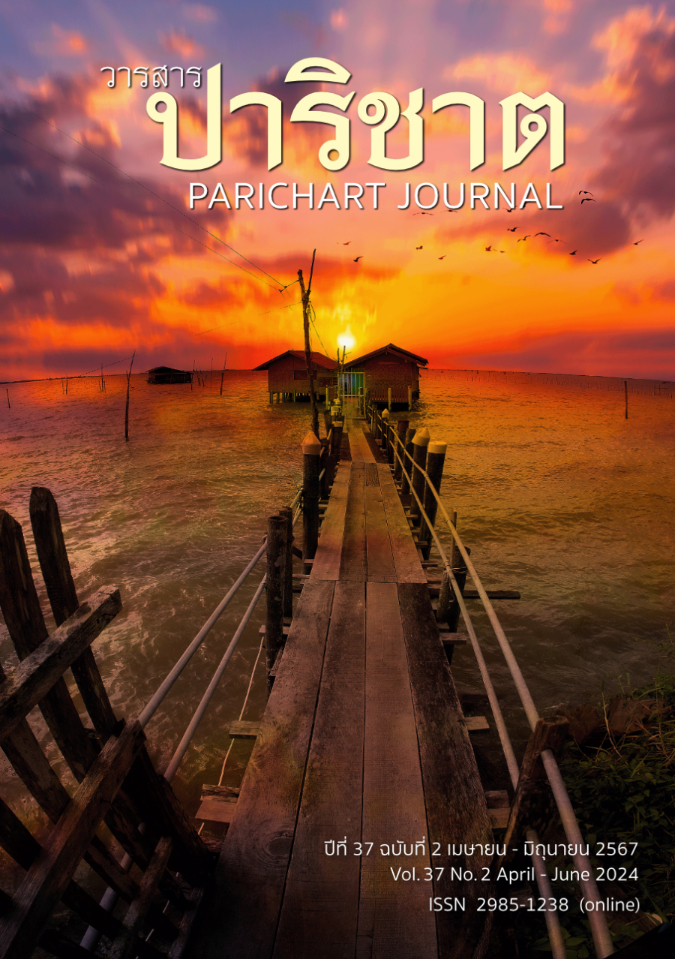Marketing Communication Through Brand Storytelling of The Communitique Products in Phayao Province
Main Article Content
บทคัดย่อ
This study constitutes a research and development method (R&D) aiming at refining marketing communication strategies through the product storytelling of communitique products in Phayao Province. The research instruments comprised the interviews on marketing communication preferences through the product storytelling related to community identity, as well as focus group discussions to exchange information and insights regarding communitique products and conveyed identity through storytelling. By using a specific purposive sampling method, the sample group involved 20 community product entrepreneurs. Content analysis for qualitative data was employed. The findings revealed that (1) the entrepreneurs aspired to possess their own product brand, name their products through storytelling, and desire contemporary publicity reaching diverse consumers; (2) critical components of the communitique product storytelling in Phayao Province necessitated having a product brand, narrative communication, product promotion, and preferred marketing communication channels; (3) the prototype marketing communication strategy through the storytelling of communitique products in Phayao Province comprised five steps: brainstorming to identify strengths, weaknesses, opportunities, and threats; identifying communication strategies for marketing; integrating various crucial components of communitique products through storytelling; training community entrepreneurs in product presentation channels; and evaluating and adjusting the strategy outcomes. The prototype marketing communication prototype through storytelling of communitique identity developed herein can be utilized to promote the communitique products in Phayao Province, emphasizing product quality, distinctiveness, and the use of various media to craft compelling narratives.
Article Details

อนุญาตภายใต้เงื่อนไข Creative Commons Attribution-NonCommercial-NoDerivatives 4.0 International License.
เอกสารอ้างอิง
Armstrong, G., Adam, S., Denize, S., & Kotler, P. (2015). Principles of marketing. Pearson.
Atkin, D. J., Hunt, D. S., and Lin, C. A. (2018). Diffusion theory in the new media environment: Toward an integrated technology adoption model. Mass Communication and Society, 18(5), 625-650.
Berger, J., & Milkman, K. L. (2012). What makes online content viral?. Journal of Marketing Research, 49(2), 192-205.
Belova, A. D. (2021). Storytelling in advertising and branding. Cognition, Communication, Discourse, 22, 13-26.
Choi, M. W. (2024). A typology of storytelling marketing: A case analysis. Journal of Logistics, Informatics and Service Science, 11, 379-391.
College of Management Mahidol University. (2019). Three weaknesses of “Thai OTOP” and five tips or success.https://www.marketingoops.com/reports/industry-insight/decoding-the-success-of-thai-local-brand/ (in Thai)
Community Development Department. Origin, Concept, and Principles of a One District One Product (ODOP) Project. (2560). http://www.cep.cdd.go.th (in Thai)
Ferrell, O. C., & Hartline, M. D. (2005). Marketing strategy (3rd Ed.). Thomson/South Western.
Fill, C., & Turnbull, S. (2019). Marketing communications. Pearson.
Ha, T. M., & Song, J. H. (2020). The influences of the storytelling advertising on advertising attitude, brand attitude and purchase intention in Korean food franchise restaurant. Journal of Brand Design Association of Korea, 28(4), 41-67.
Heath, T. B., DelVecchio, D., & McCarthy, M. S. (2011). The asymmetric effects of extending brands to lower and higher quality. Journal of Marketing, 75(4), 3-20.
Herskovitz, S., & Crystal, M. (2010). The essential brand persona: Storytelling and branding. Journal of Business Strategy, 31, 21-28.
Hinterhuber, A. (2008). Customer value-based pricing strategies: Why companies resist. Journal of Business Strategy, 29(4), 41-50.
Holt, D. B. (2003). What becomes an icon most? Harvard Business Review, 81(3), 43-49.
Pairoa, I. (2021). Impacts of online marketing communication strategies on OTOP products of Nakhon Pathom Province. Suranaree Journal of Social Sciences, 15(2), 18-40.
Kotler, P. T., & Armstrong, G. M. (2020). Principles of marketing: Global Edition (18th Ed.). Pearson Prentice Hall.
Kotler, P. T., & Armstrong, G. (2017). Principles of marketing. Pearson.
Kotler, P., & Keller, K. L. (2016). Marketing management (14th Ed.). Shanghai People’s Publishing House.
Kumphum, D., & Plianroong, S. (2021). The communication of OTOP bags’ identity by the group of producers and entrepreneurs. Journal of Humanities and Social Sciences Bansomdejchaopraya Rajabhat University, 6(1), 44-68.
Laverie, D., Humphrey, W., Manis, K.T., & Freberg, K. (2020). The digital era has changed marketing: A guide to using industry certifications and exploration of student perceptions of effectiveness. Marketing Education Review, 30(2), 1-24.
Kumkrua, M., & Chokeudomchai, T. (2019). Online marketing communication strategies via social media affecting consumer behavior in buying OTOP products in Kanchanaburi. Krungkao ARU Research Journal, 6(1). 1-8.
Narin, N., Sukiam, K., & Theerasorn, S. (2021). Service marketing MIX development for OTOP Nawaviti products in Kampaeng Sean. Journal of Lawasri, 5(2), 92-103.
Khanaraksombut, N., & Yaree, U. (2022). Community product marketing communication tool to achieve consumer path in the new normal era. Humanities and Social Sciences Journal, Ubon Ratchathani Rajabhat University, 14(1). 205-214.
Yanoi, P. (2019). Brand identity and marketing communication by participation of community for promoting tourism Kad Kuang Mueng Nan (Wat Phumin Walking Street) [Master’s thesis, National Institute of Development Administration]. National Institute of Development Administration. https://repository.nida.ac.th/items/0e998de9-4b76-4f1d-881b-350743802301
Pride, W. M., Ferrell, O. C., & Lukas, B. A. (2005). Marketing principles. Thomson/South-Western.
Putwatthana, S., & Rukumnuaykit, P. (2021). Approaches to local product development for secondary provinces through branding, packaging, and storytelling to promote tourism: A case study on a provincial cluster in Lower-Northeastern Thailand (Yasothorn, Sisaket, and Amnat Charoen). Thai Journal of Public Administration, 19(2), 71-96.
Wulf, K.D., Odekerken, G., Goedertier, F., & Ossel, G.V. (2005). Consumer perceptions of store brands versus national brands. Journal of Consumer Marketing, 22(4), 223-232.
Uusitalo, O., & Rökman, M. (2007). The impacts of competitive entry on pricing in the Finnish retail grocery market. International Journal of Retail and Distribution Management, 35(2), 120-135.
Anunchaitawat, V., & Sunhachawee, B. (2018). Marketing communication through the story creation of OTOP fabric cluster in Chiang Mai Province. Far Eastern University Academic Review Journal, 12(1), 252-265. (in Thai)


